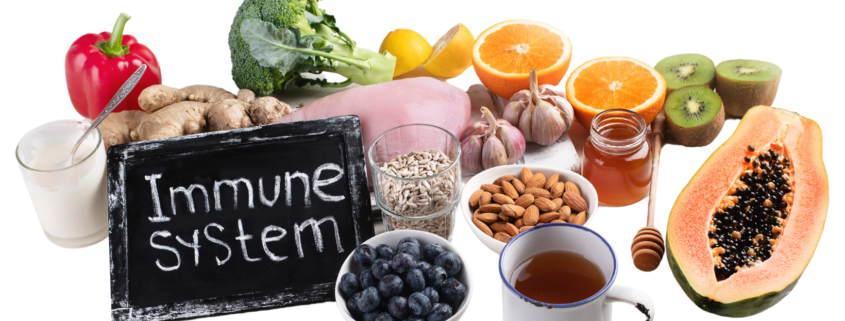Build a Strong Offense in Your Kitchen
We’ve heard in sports and military combat that the best defense is a strong offense. This strategy can also apply to our health when it comes to being proactive in preventing acute inflammation and disease. Nutrition plays a vital role in building a strong immune system to fight off foreign invaders. We want our immune system to be prepared in advance to defend our healthy cells against invasion of harmful bacteria and viruses.
- The first offensive weapon in our immune system playbook is pre-planning. By pre-planning, we prevent mealtime stress and increase the chances of achieving our healthful eating goals. The next weapon is a varied diet. Healthy eating involves variety because our bodies need different nutrients from different foods on a daily basis. We want to include an array of food groups including fruits, vegetables, whole grains, protein, dairy products, and healthy fats. A third strategic weapon for achieving and maintaining good health is to have plentiful antioxidants every day. All three of these strategies work together: If you focus on planning your meals in advance to incorporate variety among these food groups, it will help ensure you are consuming adequate amounts of antioxidants which serve to protect your healthy cells from damage and disease.
Some foods are receiving attention for maybe boosting and building a strong immune system. We have listed some of these below. Consider incorporating them into your recipes and meals to increase variety in your diet, provide a source of antioxidants, and add other important nutrients and fiber. However, it’s important to remember that there isn’t one food that will magically build a strong immune system and prevent disease – the key is variety at each of your three meals every day.
Healthful foods that might boost your immune system:
The foods listed below provide a variety of nutritious benefits including antioxidants such as resveratrol, lutein, avenanthramides, flavonoids, vitamins A, E, K, plus plant fibers and omega 3 fatty acids.
Oats: Use oats as an alternative to breadcrumbs to coat chicken or fish, or make overnight oats for breakfast. Recipes abound for muffins, breads, cookies, pancakes, and waffles that incorporate oats.
Leafy greens: Kale, spinach, swiss chard, arugula . . . Dark green is an important vegetable color. The darker the color, the more nutrients present. Incorporate greens into your salads, sauté them with olive oil, season with salt and pepper, add them to soups during the last few minutes of cooking, use them as wraps in place of a tortilla, blend them into smoothies, or make a pesto sauce.
Broccoli: Add broccoli to soup, pasta sauce, pizza toppings, quinoa dishes, smoothies, slaw, stir-fry, and salads.
Red Peppers: All colors of peppers have nutritional benefits, but red peppers may be slightly higher in antioxidant and phytonutrient levels because they are riper than yellow or green peppers. Add peppers to salads, sandwiches, and stir-fry dishes. You can make stuffed peppers, or use your blender or processer to add peppers to soups or dips.
Grapes: Mix grapes with vanilla yogurt and top with toasted pecans. Blend frozen grapes, milk, banana, and Greek yogurt for a breakfast smoothie. Sprinkle grapes into chicken or tuna salad, freeze them for a snack, or add them to salads or oatmeal.
Berries: Increase your intake of all berries. One cup daily would be great! Add berries to overnight oats, salads, and fruit parfaits. You can also dip fresh berries in yogurt and freeze for a snack.
Cinnamon: Add cinnamon to roasted sweet potatoes, oatmeal, or baked apples. You might also try cinnamon in granola, hot cocoa, or coffee.
Ginger: Add a few pieces of fresh ginger in hot water to make tea, or you can add up to 1 teaspoon of ground ginger to your morning coffee. Add a bit of fresh ginger to your smoothie, choose ginger jam for your toast, or add fresh or dried ginger to homemade salad dressing.
Garlic: Add garlic to pasta sauce, salsa, salad dressings, guacamole, soups, stews, sautéed vegetables, pizza, and mashed potatoes.
Fatty Fish: Enjoy some albacore or bluefin tuna, salmon, Atlantic herring, mussels, anchovies, swordfish, sardines, halibut, rainbow trout, or mackerel!
Walnuts and Almonds: Add crunch and protein to salads, oatmeal, yogurt, or any vegetable side dish with roasted or raw almonds. Incorporate them into muffins, breads, and cookies.
Chia Seeds: Try adding a couple of tablespoons to smoothies, or as a topping on yogurt, cereal, and salads. You can also use them in salad dressings, stir-fry, or as a crispy crumb coating for meat or fish. Bake them into cookies, breads, or muffins, or add them to soup, dips, or meat balls.
Consider incorporating more of these foods in your nutrition and health arsenal. Have fun! ☺
-CB



